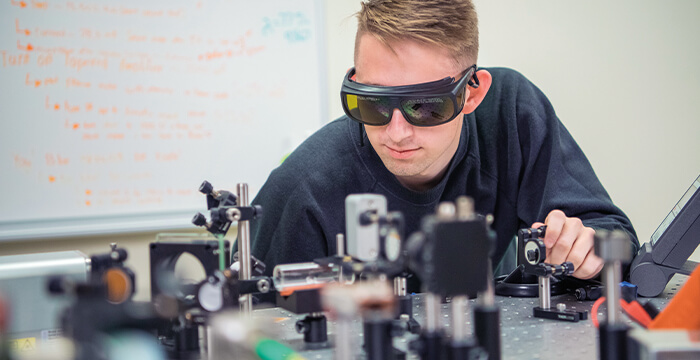Fund of Knowledge
A magnanimous total of five National Science Foundation grants are among multiple sources currently financing cutting-edge research at St. Norbert.
The thrill of discovery is an essential part of the educational journey for students and faculty at St. Norbert College. It’s a journey in which the college finds willing partners – among them the National Science Foundation (NSF). SNC currently has five active research grants from the influential federal agency.
“It’s exciting to see St. Norbert College, a primarily undergraduate institution, engaging with the NSF at this level,” says Colette St. Mary of the Directorate for Biological Sciences, who manages one of the SNC awards for the NSF. “Attracting proposals from a diverse array of organizations is one of the primary ways we hope to broaden participation and we recognize it cannot happen without strong institutional support for research.”
David Bailey (Biology), associate vice president for academic affairs, says: “These grants are a testament to the scholarly pursuits of St. Norbert’s bright and talented faculty, who remain deeply committed to the education and training of our students while advancing knowledge in their respective fields. Each of these grants showcase and leverage our state-of-the-art science facilities and equipment.”
As you explore the details of these NSF-funded projects take a moment to imagine their impact:
- Students are growing.
- SNC professors are furthering their research.
- Discoveries are being made that impact our greater world.
Collaborative Research: Study of the Connections between Ordering, Dynamics and Glass Forming Ability in Metallic Liquids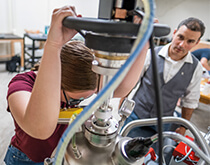 Amount: $229,325
Amount: $229,325
Principal investigator: Nicholas Mauro (Physics)
Purpose: You’re probably familiar with the term “heavy metal,” but what about “glass metal?” This grant funds investigations of different metals that form unusual solid phases called “glasses.” The project aims to distinguish glass-forming ability using a new technique involving neutron scattering. This technique allows the team to measure how long it takes for atoms to rearrange themselves as liquid cools into the solid state.
Of particular interest: In a recent publication, the team studied the cooling of a particular type of metal liquid. They were surprised to learn that the structure and movement of the atoms seems to clearly have a low temperature and a high temperature behavior. This suggests other similar metals might also show this kind of behavior.
Quoted: “Through this work, my students make meaningful contributions, develop important skills for their future careers and get a sense for the research process outside of the confines of the classroom. We hope to develop programs that connect underrepresented communities to STEM researchers and start to evaluate the most effective ways to get these students into STEM careers.” – Nicholas Mauro (Physics)
Creating a Minor in Education as a Pathway for Science, Math or Computer Science Majors to Obtain Teaching Licensure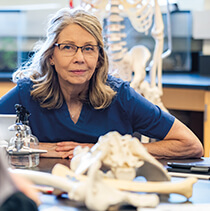 Amount: $118,360
Amount: $118,360
Principal investigator: Deborah Anderson (Biology)
Co-principal investigators: Reid Riggle (Education), Patricia Norman (Education), Chris Bradford (Education), Seth Meyer (Mathematics)
Purpose: This project is a partnership between SNC and Northeast Wisconsin Technical College (NWTC) that aims to create a new pathway toward teaching licensure for STEM majors. The funding of the grant led to development of the 4-12 Teaching & Natural Sciences major, the science licensure proposal which was submitted to the state of Wisconsin, and a partnership with NWTC to facilitate transfers from their lab sciences program into SNC’s secondary education program.
Of particular interest: The resources provided by this award (which is within the NSF Robert Noyce Scholarship Program) are helping investigators and collaborators build the capacity needed to submit a Track I proposal; a highly-competitive Track 1 win would additionally allow SNC to offer scholarships to students interested in completing the new major.
Quoted: “When I found out I was able to both finish my undergraduate degree in natural science and pursue a degree in education, I realized I was being given a chance to fulfill both of my goals. The horizon is infinite!” – Cyan Hite ’22, Teaching & Natural Sciences major
RUI: Microwave to Optical Frequency Conversion Through Six-Wave Mixing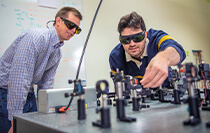 Amount: $247,964
Amount: $247,964
Principal investigator: Erik Brekke (Physics)
Purpose: This grant provides funding for experimental atomic-molecular-optical research involving lasers, and includes support for equipment as well as summer research positions for two physics students. As Brekke explains, his team studies how to control the frequency of typical lasers and how to create new lasers from the interaction of existing lasers with atoms. The next realm his team is exploring is converting between optical (red) laser and microwave wavelength lasers.
Of particular interest: The team has obtained several new laser systems and is feeling energized as they set up the last few. They have already successfully excited high-energy level “Rydberg states” and seen microwave transitions between them.
Quoted: “I hope this work provides continuing excellent experiences for our students to get involved in research – experimental design, data collection, analysis, publication – that can give them a sense for where they might go in the future.” – Erik Brekke (Physics)
Collaborative Research: Targeted Neurosteroidogenesis and Complex Memory Function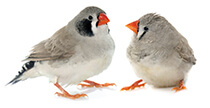 Amount: $193,086
Amount: $193,086
Principal investigator: David Bailey (Biology)
Purpose: What are the impacts when hormonal and electrical signaling processes interact in the human body? How are complex behaviors like memory function affected? These are questions being examined by Bailey’s team, which recently documented a combination of these two signaling systems. One example they’re investigating is known as estrogen synthesis at the synapse (SES). Using the zebra finch, a species with abundant SES, they seek to better understand how SES impacts learning, storage and recall of information. This program will also welcome high-school teachers and undergraduate students into the labs for summer internships, and will develop a new course in neuroanatomy.
Quoted: “The broader impacts of this study are numerous. It can help further our understanding of the development and adaptation of the central nervous system in vertebrate animals. It will further our understanding on why estrogens fluctuate in the brain and could point to benefits of supplementing these levels in ways such as your diet.” – Jack Hanauer ’22, research partner
Community-Building, Mentoring and Research Experiences to Develop Undergraduate STEM Majors’ Scientific Identities and Preparation for STEM Careers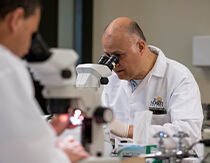 Amount: $998,759
Amount: $998,759
Principal investigator: Anindo Choudhury (Biology, Environmental Science)
Co-principal investigators: David Bailey (Biology), Jamie Lynch (Sociology), Timothy Flood (Geology)
Purpose: This program provides four-year scholarships, along with research and mentoring programs, to 15 high-achieving STEM students. With nearly $1 million granted, this is St. Norbert College’s largest federal research grant to date, says Choudhury. The program is designed for exceptional students who could otherwise face financial challenges to accessing an education at SNC. Scholars are offered robust opportunities that include living-learning communities, participation in faculty-mentored research and a seminar series. Components of the program will also be available to the general SNC population. This will serve to broaden the grant’s impact, as will a research study examining how students develop their scientific identity.
Of particular interest: During the summer of 2022, five students supported by this scholarship program secured summer fellowships at other prominent research facilities across the country.
Quoted: “This is the most meaningful grant I’ve been involved with in terms of scope and impact. We have the opportunity as an institution to make a difference in the lives of very talented students and foster their development. My hope is that as an institution we will also use the information and experience we’ve developed for further grants and support of this nature.” – Anindo Choudhury (Biology, Environmental Science)
A long-standing investment
St. Norbert College has benefited from multiple NSF grants over the years, including:
- $30,400 in 1987 for research into the use of Nuclear Magnetic Resonance Spectroscopy in Undergraduate Chemistry Instruction – principal investigator David Klopotek ’64 (Chemistry)
- $254,471 in 1994 towards the renovation of the John Minahan Science Hall (the predecessor of today’s Gehl-Mulva Science Center on campus) – principal investigator Jim Hodgson (Biology)
- $132,262 and $108,000 in 1994 and 1996 for initiating projects in the Mathematics Achievement & Performance in Science (MAPS) for Native American Young Scholars program – principal investigators Bonnie Berken (Mathematics) and Larry Thorsen (Mathematics)
- $500,000 in 2007 for developing Natural Science PRIDE: A Program to Promote, Recruit, Involve, Develop & Employ Students in Mathematics & Computer Science – principal investigators John Frohliger ’85 (Mathematics) and Bonnie McVey ’82 and Dave Pankratz ’69 (Computer Science)
- $108,560 in 2007 for Collaborative Research: Leading Indicators of Regime Shift, an Ecosystem Experiment – principal investigator Jim Hodgson (Biology)
- $190,386 in 2011 for Geoscience Preparation for K-8 Pre-Service Teachers: Including Testing the Significance of an Intensive Field-based Experience – principal investigators Tim Flood (Geology) and Scott Kirst (Education).
Oct. 31, 2022





